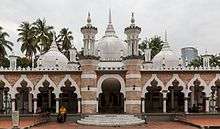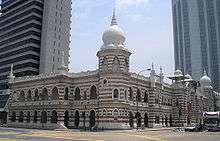Arthur Benison Hubback
| Arthur Benison Hubback (A. B. Hubback) | |
|---|---|
| Born |
Arthur Benison Hubback 13 April 1871 74, Rodney Street, Liverpool, England |
| Died |
8 May 1948 (aged 77) 4 The Hollies, Broxbourne, Hertfordshire, England |
| Nationality | British |
| Occupation | Architect |
Arthur Benison Hubback (13 April 1871 – 8 May 1948) was a British architect and soldier who designed several important buildings in British Malaya. He was active in sports, especially football and cricket.[1] Hubback was promoted to Brigadier General during his service in the British Army.[2]
Early life
Arthur Hubback was born in Liverpool, England, in 1871, son of Joseph Hubback (1814–1882), who was Lord Mayor of Liverpool in 1870 and a merchant, and Georgina (born Eliott-Lockhart). Arthur attended Fettes College, Edinburgh, and then started work as an apprentice for the city architect in Liverpool, Thomas Shelmerdine.[3][4]
Career in architecture

In 1895, Hubback became chief draughtsman of Selangor public works department, which was then working on the building of government offices now known as Sultan Abdul Samad Building. The Sultan Abdul Samad Building was originally designed by A.C. Norman and R. A. J. Bidwell in a Classic Renaissance style, but Norman's plan was then reworked on by Bidwell in an Indo-Saracenic or Moorish style, and Hubback also worked on the building.[5] After work on the building was finished in 1897, he worked in private practice for a few years, before returning to public work in 1901.
_(south)%2C_central_Kuala_Lumpur.jpg)
From then until the outbreak of World War I was a period of great construction projects, and he worked on buildings in Malaya and Hong Kong, from mosques to railway stations.[3] An important work designed by Hubback is the Kuala Lumpur railway station. Among other major works he designed are the Jamek Mosque, Kowloon railway station, and Ipoh railway station. He designed at least 25 buildings in Malaya, and many of these are now considered an important part of the architectural heritage of Malaysia.[4]
He returned to England in 1914 and did not design any further buildings in Malaya, although some of his buildings were not completed until later.
Military service
Hubback took charge in the Federated Malay States Volunteer Rifles Force (M.S.V.R.) in 1907. He was appointed as a Major in the M.S.V.R. in 1910 and he was in command of F.M.S. Contingent to George V's coronation in 1911. He was then promoted as Lt. Colonel in the M.S.V.R. in 1912.
In 1914, at the start of World War I, he became a major in the 19th battalion, London (territorial) regiment. In 1915, he was the Lt. Colonel commanding the 20th London Regiment Territorial Force, 47th Division B.E.F. He served in France, The Soanne, Brigadier of 19th and 20th London Battalion.He became Brigadier General of 2nd Infantry Brigade, 1st Division in 1916, and Brigadier General Co. of the 63rd Infantry Brigade, 37th Division B.E.F. in 1918. During the war he was mentioned in dispatches six times, and won the CMG and Distinguished Service Order. Following the war he continued in the military, commanding the 5th London infantry brigade of the territorial army from 1920 to 1924.[3]
Family
Hubback married Margaret Rose Frances (Daisy) Voules, the sister of a colleague, in 1901 and they had two children, a son (Arthur Gordon Voules Hubback, R.N.) and a daughter (Yvonne Hubback).[3]
He had two brothers. Theodore Rathbone Hubback joined Arthur in Malaya, and was a civil engineer and contractor, as well as working for a while as a rubber planter, and after early adventures as a big game hunter became a conservationist and author. George Clay Hubback was bishop of Assam and of Calcutta.
He died in Broxbourne, Hertfordshire, on 8 May 1948 of heart failure.[3]
Buildings


Hubback worked on the buildings including:
- (1894–1897)
- Federal Secretariat(Sultan Abdul Samad Building), ground plan based on A. C. Norman's design with elevations by R. A. J. Bidwell. Hubback contributed to the design and also designed the fixtures of the building.
- 1901
- Carcosa Seri Negara, Kuala Lumpur (A.C. Norman)
- 1904
- Municipal Office & Town Hall, Kuala Lumpur (Sanitary Board/Town Hall)[6]

- 1905
- F.M.S Central Railways Offices, Kuala Lumpur (currently National Textile Museum)[7]
- Shop Houses on Old Market Square, Kuala Lumpur[8]
- 1906
- Residence of High Commissioner, Kuala Kangsar
- Selangor Museum, Kuala Lumpur. Rebuilt, (National Museum)
- 1907

- 1909
- Jamek Mosque, Kuala Lumpur[11]
- The Big School Malay College, Kuala Kangsar (Malay College Kuala Kangsar)[12]
- The White House of Klang (The Sultan Abdul Aziz Royal Gallery)[13]
- 1910
- Andersons Boy School, Ipoh[14]
- Railway Station & Hotel, Kuala Lumpur[15]
- Selangor Club 1910, Kuala Lumpur (Royal Selangor Club)
- Federal Survey Office, Kuala Lumpur

- 1911
- 1912
- British Residency, Seremban (Kompleks Kraf Negeri Sembilan [Handicraft Centre])[18]
- Preparatory School, Malay College Kuala Kangsar (MCKK) – Prep School, Kuala Kangsar, Perak
- 1913
- Kowloon railway station, Hong Kong (Demolished in 1977, only the Clock Tower remains)
- 1914
- Selangor Museum (Extension & alteration) Kuala Lumpur
- 1915
- Supreme Court, Kuala Lumpur (Kuala Lumpur High Court)
- 1916
- Town Hall and Post Office, Ipoh[18]
- 1917
- Idris Memorial Mosque, Kuala Kangsar (Ubudiah Mosque)[18]
- Malay Railway Administration Building, Kuala Lumpur[19]
- 1920
- Railway Station & Hotel, Ipoh (Ipoh railway station)[20]
Source Included From: A.B Hubback: An Architectural Celebration in Malaya Exhibition. Located at National Textile Museum, Kuala Lumpur.
Jointly Organized by PAM Heritage Conservation Committee, Department of Museums Malaysia and National Textile Museum
Officially Supported by Masjid Jamek, British Council, Arch, webmaster of thehubbacks.org, midor, ALFO, MIBOUTIQUE and Kuala Lumpur.
The significance of Hubback’s work
Hubback’s architectural work, on the one hand, is rooted in 19th-century eclectic historicism. He took Mughal forms and melded them with Byzantine, Romanesque, and Gothic details to form a ‘new’ kind of architecture known as Indo-Saracenic.[21] The first major work Hubback was involved in, the Sultan Abdul Samad Building, is in this style. It was largely the work by R. A. J. Bidwell following the design direction set by the State Engineer Charles Edwin Spooner, and Hubback made additions and alterations to the building under Spooner's instructions.[22] This strand of English colonial architecture was based on Indian Islamic architecture and not native to Malaya. Hubback and Bidwell effectively introduced into the Malaysian architectural vocabulary the onion dome. His principal building formed the perimeter of the Padang or Merdeka Square, and became a symbol of the colonial administration. The Federal Secretariat/Sultan Abdul Samad Building is as much a part of the architectural consciousness of Malaysia as the Houses of Parliament is to Britain.[23]
The twentieth-century quality of his architectural output is that he created a number of large buildings to house the colonial government's administrative functions, an architectural recognition of the increasing spatial demands of an official bureaucracy, but in elegant dress. While in post-independence Malaysia these functions have moved elsewhere, these buildings remain as a potent visual symbol of the country and its multicultural heritage.
Honours
- 1905 Associate of the Royal Institute of British Architects[3]
- 1909 Fellow of the Royal Institute of British Architects[3]
- 1913 Honorary Diocesan Architect for the Diocese of Singapore[24]
- 1916 Companion of the Order of St Michael and St George[3]
- 1918 Distinguished Service Order.[3]
Sports
Hubback was an active sportsman who played the following sport:[25]
- 2 June 1894 – Played Cricket for Liverpool in the Liverpool vs. Birkenhead Park match, Aighburth Liverpool.
- 9 September 1896 – Made his first century in cricket
- 4 February 1897 – Played cricket in Selangor vs. Singapore match.
- 24–25 October 1897 – Took leave to play for the Straits Settlements Cricket Team in a Cricket Festival in Hong Kong.
- 8 November 1897 – Played in the Interport matches: 1897/98 Hong Kong and Shanghai vs. Straits Settlements, Hong Kong Cricket Club Ground, Hong Kong
- 14 November 1897 – Played in the Interport matches: 1897/98 Hong Kong and Shanghai vs. Straits Settlements, Hong Kong Cricket Club Ground, Hong Kong.
- November 1899 – Represented F.M.S in a cricket match in Burma.
- 4 February 1905 – Played in Straits Settlements in F.M.S cricket match, F.M.S vs. Straits Settlements at the Padang Kuala Lumpur.
- 1906– Captained the F.M.S team in a cricket match in Burma
- 16 August 1906 – Cricket match, F.M.S in Straits in Straits Settlements 1906, Straits Settlement vs. Federated Malays States at the Padang, Singapore.
- 30 March 1907 – Played in Straits Settlements in Federated Malay States 1906/07
- 5 August 1907 – Played in F.M.S in Straits Settlements 1907 cricket match, Straits Settlements vs. F.M.S at Penang Cricket Club Ground, Penang.
- 31 July 1908 – Played in F.M.S inStraits Settlements cricket match 1908, Straits Settlements vs. Federated Malay States, The Pedang, Singapore.
- 30 January 1911 – Played in Straits Settlements in Federated Malay States cricket match 1910/11, F.M.S vs. Straits Settlements, The Pedang Kuala Lumpur.
References
- ↑ "Kuala Lumpur Sports". The Straits Times. 7 February 1902. Retrieved 17 June 2014.
- ↑ "Untitled". The Singapore Free Press and Mercantile Advertiser. 13 October 1917. Retrieved 17 June 2014.
- 1 2 3 4 5 6 7 8 9 Gullick, J.M. (2007). "Hubback, Arthur Benison". Oxford Dictionary of National Biography. Retrieved 17 February 2014.
- 1 2 "The Man Behind Malaysia's Iconic Buildings: Arthur Benison HubbackExpatGo Staff". Expatgo. August 13, 2014.
- ↑ Zain Abdullah (June 23, 2014). "Sultan Abdul Samad Building's Architectural Highlights". Virtual Malaysia.
- ↑ "Sanitary Board/Town Hall, Raja Road, Kuala Lumpur, Selangor". flickr. Retrieved 17 June 2014.
- ↑ "Former FMS Railways Central Offices". warisan peliharaan. Retrieved 17 June 2014.
- ↑ "Market Square (Medan Pasar) Shophouses (Sin Seng Nam Restaurant), Kuala Lumpur, Selangor". flickr. Retrieved 17 June 2014.
- ↑ "Wisma Kastam (Malayan Railway Building)". penang travel trips. Retrieved 17 June 2014.
- ↑ "Untitled". The Victorian Web. Retrieved 17 June 2014.
- ↑ Demissie, Fassil (2012). Colonial Architecture and Urbanism in Africa. p. 98.
- ↑ "Malay College (MCKK) – Malay Residential School, Kuala Kangsar, Perak". flikr. Retrieved 17 June 2014.
- ↑ "About Us". Galeri di Raja. Retrieved 17 June 2014.
- ↑ "ANDERSON SCHOOL – IPOH, PERAK". The Hubback Brothers Tribute. Retrieved 17 June 2014.
- ↑ Middleton, William D. (2012). On Railways Far Away. Indiana UP. p. 236.
- ↑ "Patients' Activities in the Central Mental Hospital (Hospital Bahagia Ulu Kinta), Tanjung Rambutan". Ipoh World. Retrieved 17 June 2014.
- ↑ "Thursday October 18, 2007 White House becomes Royal Gallery". The Star Online. Retrieved 17 June 2014.
- 1 2 3 "Brigadier General Arthur Benison Hubback – Empire Builder". The Thrifty Traveller. Retrieved 17 June 2014.
- ↑ "Malayan Railway Administration Office (KTM Berhad)". Dewan Budaya. Pusat Pengajian Seni, Universiti Sains Malaysia.
- ↑ "Untitled". Ipoh Tourism. Retrieved 17 June 2014.
- ↑ Ariffin, Amanda Suriya (8 June 2014). "Architect of History". New Sunday Times: 8–9.
- ↑ Gullick, J.M. (1992). "The Bangunan Sultan Abdul Samad". Journal of the Malaysian Branch of the Royal Asiatic Society. 65 (1): 27–38. JSTOR 41493197.
- ↑ National Textile Museum, Malaysian Institute of Architects (PAM) (May–June 2014). "A.B. Hubback: an Architectural Celebration in Malaya". exhibition.
- ↑ "SOCIAL AND PERSONAL". The Straits Times. 11 August 1913. Retrieved 17 June 2014.
- ↑ A.B. Hubback: An Architectural Celebration in Malaya Exhibition. Located at National Textile Museum, Kuala Lumpur. "The Life and Time of A.B. Hubback", 17 May 2014, 9.30am–12pm. Dialogue with Dr. Peter Barbor (Grandson of A.B. Hubback), Mr. Llyod Gan (webmaster of thehubbacks.org) & Ar. Rosli Mohd Ali (PAM Heritage Conservation Committee).
External links
| Wikimedia Commons has media related to Arthur Benison Hubback. |

